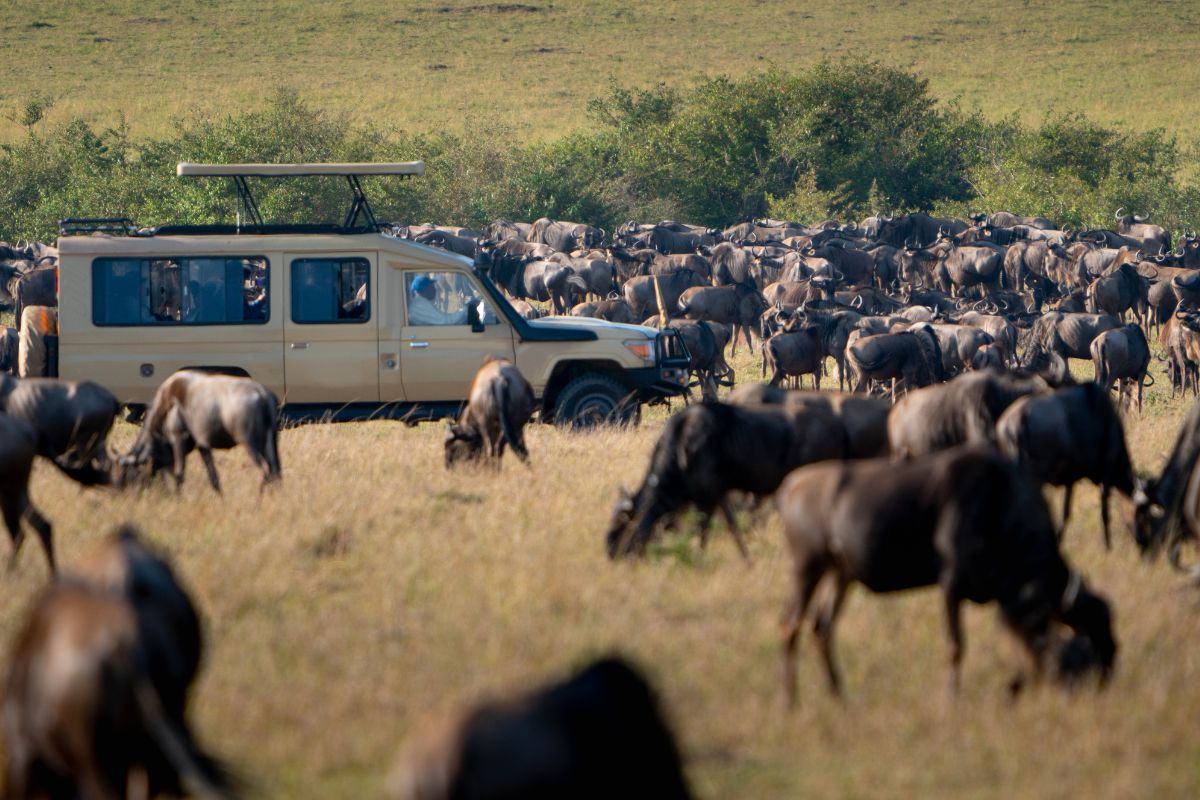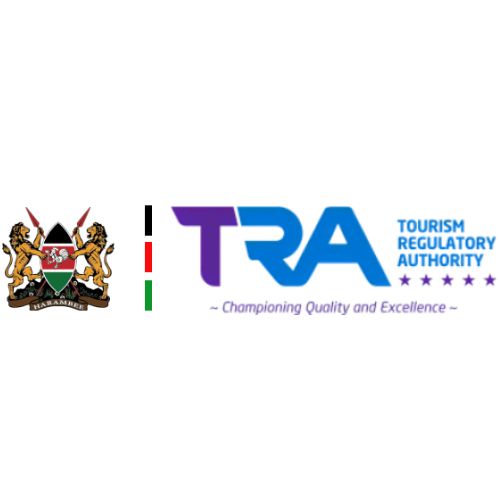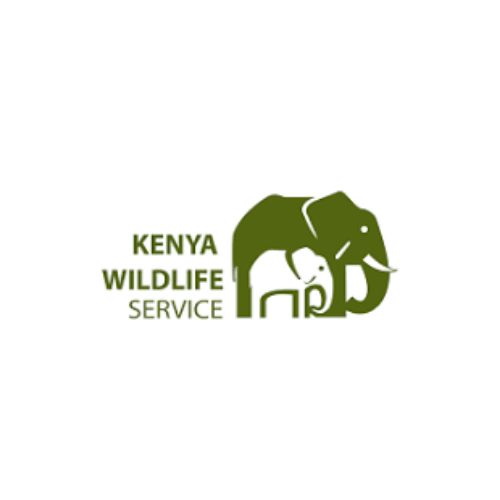Experiencing the Great Migration Masai Mara river crossing is unforgettable, but preparation can make your safari safer, more comfortable, and highly rewarding. Understanding what to bring, how to dress, and the best practices in the wild enhances every moment of your adventure:
+254 703 829 961
Great Migration Masai Mara River Crossing 2025: Go To Africa

Each year, over 1.5 million wildebeest and zebras undertake a perilous journey across crocodile-infested rivers during the Great Migration Masai Mara river crossing. This extraordinary wildlife spectacle draws travelers from all corners of the globe, offering unforgettable encounters with Africa’s raw beauty. At Sparwild African Tours and Safaris, we guide adventurers to witness this phenomenon safely, responsibly, and memorably. The Great Migration Masai Mara river crossing is more than a sight to behold — it is a transformative journey into Kenya’s wild landscapes that creates life-long memories.
What Makes the Great Migration Masai Mara River Crossing Unforgettable
The Great Migration Masai Mara river crossing is one of the most spectacular wildlife events on the planet, drawing millions of travelers eager to witness nature in its rawest form. Every year, wildebeest, zebras, and gazelles navigate dangerous river crossings, creating moments of tension, excitement, and awe. Our team ensures guests experience this event safely, responsibly, and with deep insight, turning each safari into a transformative adventure. The Great Migration Masai Mara river crossing is more than just an observation — it is an immersive journey into Kenya’s wild landscapes, connecting travelers to Africa’s heartbeat:

1. Epic Wildlife Movements
The Great Migration Masai Mara river crossing is defined by massive animal movements that highlight nature’s incredible rhythms:
- Massive Herd Dynamics: Millions of wildebeest and zebras move together, displaying coordination and instinctive behavior that captivates every visitor.
- Unexpected Behavior: Sudden halts, river hesitations, and stampedes offer unique experiences for travelers seeking close encounters with wildlife.
2. Predator Encounters
Predators play a crucial role in the Great Migration Masai Mara river crossing, creating dynamic and thrilling scenes:
- Lions in Action: Lions strategically hunt during river crossings, offering insight into the balance of life and survival.
- Crocodile Threats: Crocodiles waiting in rivers add suspense and drama to every crossing, highlighting the challenges of migration.
Hyena Opportunism: Hyenas adapt to changing herds, demonstrating the intricacies of the predator-prey dynamic. Experiencing these predator interactions during the Great Migration Masai Mara river crossing is a highlight of any safari adventure.
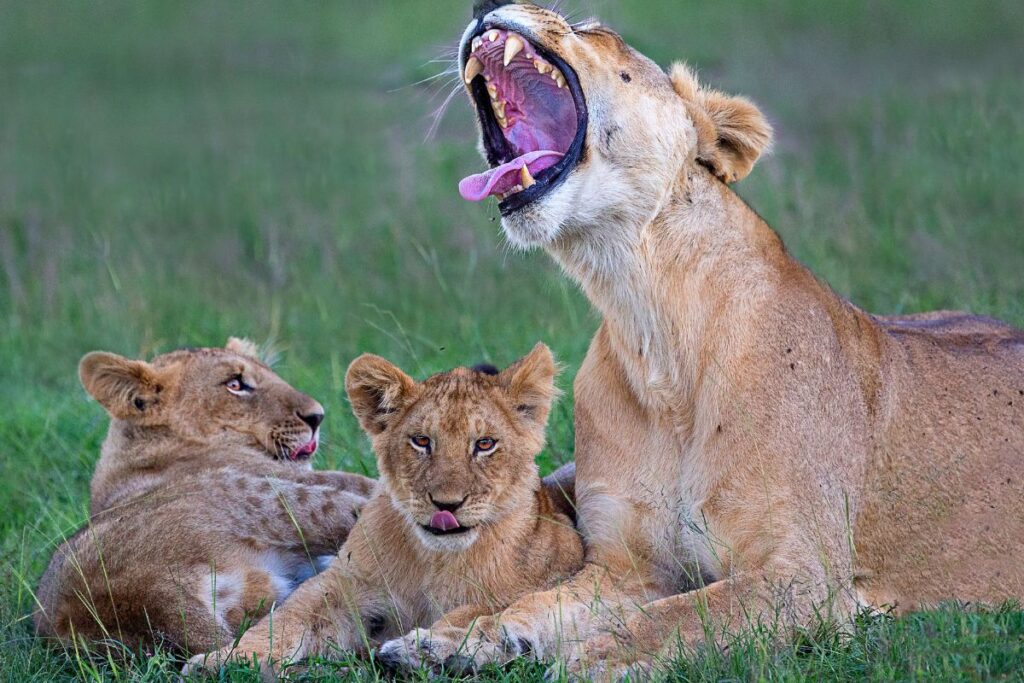
3. Stunning Landscapes
The natural beauty surrounding the Great Migration Masai Mara river crossing is as compelling as the wildlife itself:
- Mara River Vistas: Wide riverbanks, flowing waters, and dramatic currents provide breathtaking backdrops.
- Rolling Savannahs: Expansive plains allow travelers to witness the scale and grandeur of the migration.
- Dramatic Skies: Sunrises and sunsets enhance the colors of the landscape, perfect for photography and immersive viewing.
The combination of vast herds and scenic beauty makes every Great Migration Masai Mara river crossing experience unforgettable.

4. Cultural Connection
The Great Migration Masai Mara river crossing is deeply intertwined with local communities, offering travelers unique cultural perspectives:
- Maasai Insights: Learn how migration patterns shape Maasai pastoral life and seasonal traditions.
- Traditional Practices: Observing daily routines and ceremonial customs adds depth to the wildlife experience.
Community Engagement: Interacting with local communities enriches the safari experience beyond observing the migration.
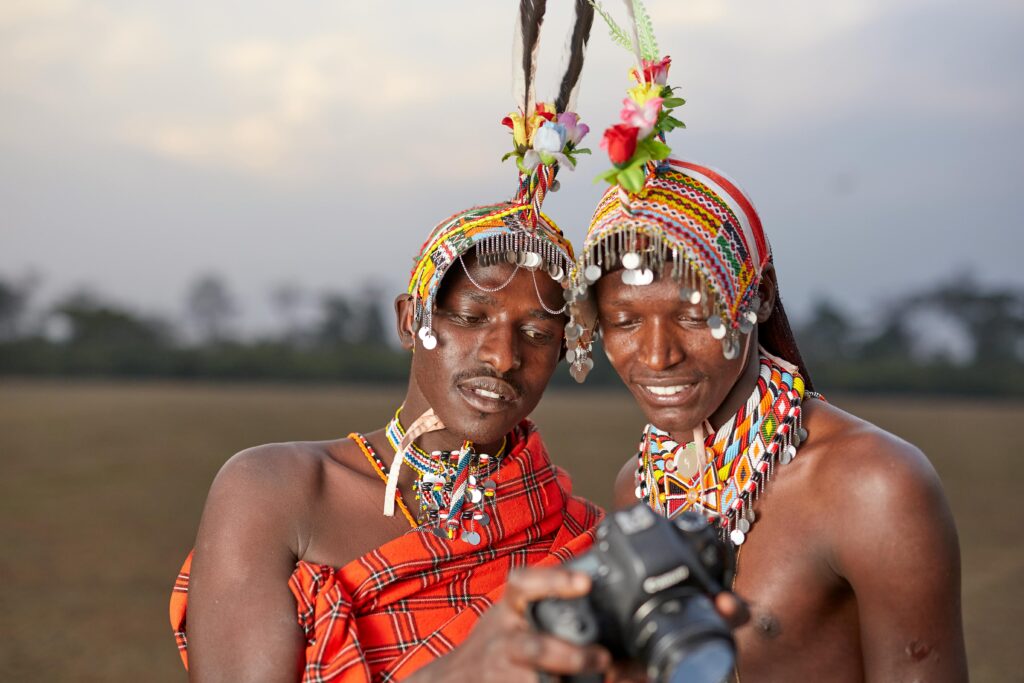
By combining wildlife spectacle, predator interactions, breathtaking scenery, and cultural immersion, our safaris deliver the ultimate Great Migration Masai Mara river crossing experience. Each trip is curated to ensure travelers witness one of Africa’s most iconic events safely, memorably, and in a way that connects deeply to Kenya’s wilderness.
Best Seasons to Witness the Great Migration Masai Mara River Crossing
Timing is everything when it comes to experiencing the Great Migration Masai Mara river crossing. Knowing which months offer the most dramatic wildlife action ensures you make the most of your safari adventure and capture unforgettable moments:
Best Seasons to Witness the Great Migration Masai Mara River Crossing
| Season | Months | Migration Highlights | Safari Experience | Best For |
|---|---|---|---|---|
| Early Dry Season | June – July | Wildebeest herds start approaching the Mara; first river crossings may begin | Moderate crowds, fresh green landscapes | Travelers seeking quieter safari and early migration sights |
| Peak Dry Season / Main Crossing | July – October | Highest chance of witnessing dramatic river crossings; predators active along Mara River | Full migration spectacle, thrilling wildlife encounters | Wildlife photographers and first-time migration viewers |
| Short Rains / Low Crossing | November | Smaller groups of wildebeest may cross; less predictable patterns | Lush scenery, fewer tourists | Travelers seeking scenic landscapes with fewer crowds |
| Long Rains / Migration Away from Mara | April – May | Herds mostly in Serengeti, Kenya sees minimal crossing activity | Limited river crossing action | Travelers focusing on other Kenya safaris or budget trips |

1. Early Dry Season (June – July)
The early dry season marks the start of the northward migration, with wildebeest and zebras gradually moving toward the Mara River. Herds are smaller, which allows travelers to observe intimate interactions between animals and predators. The Mara landscape is still lush, with green plains providing a stunning backdrop for photography. This period is ideal for travelers who prefer fewer crowds, closer wildlife encounters, and a more personalized safari experience. Expert guides ensure that visitors can track movement patterns and witness the migration in a safe, informed, and immersive way.
2. Peak Dry Season / Main Crossing (July – October)
This is the pinnacle period for witnessing the river crossings, when massive herds converge at the Mara River. Crocodiles, lions, and hyenas create dramatic predator-prey interactions, offering some of the most thrilling wildlife experiences on the planet. Game drives are timed strategically to maximize sightings of multiple crossings in a single day. Early mornings and late afternoons provide perfect lighting for photography, enhancing the visual drama of the migration. This season is ideal for first-time visitors, wildlife enthusiasts, and photographers seeking unforgettable, high-adrenaline encounters. Traveling with experienced guides ensures safety and enhances the narrative of every encounter with the migration.

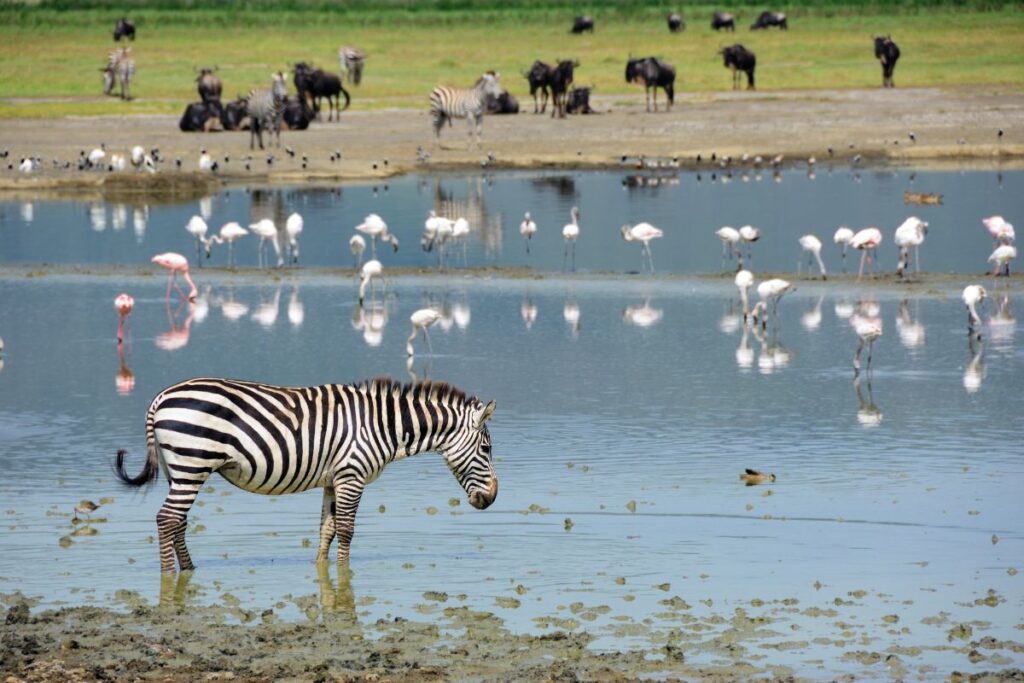
3. Short Rains / Low Crossing (November)
During the short rains, the migration is still present in the Mara but river crossings are less frequent and more sporadic. This season transforms the Mara into a lush, vibrant landscape, teeming with birdlife and green savannahs. Lower tourist numbers provide more privacy and intimate wildlife experiences. Photography opportunities shift toward capturing the contrast of vibrant landscapes and wildlife, rather than sheer herd mass. For travelers seeking a quieter safari with a focus on scenery and wildlife diversity, this is an excellent time to visit.
4. Long Rains / Migration Away from Mara (April – May)
In the long rains, most wildebeest herds remain in the southern Serengeti, meaning fewer river crossings in the Mara. Despite this, Kenya’s parks offer rich wildlife diversity, excellent predator sightings, and a green, photogenic environment. Lush vegetation, swollen rivers, and abundant bird species make this season perfect for nature-focused safaris. Travelers during this period often enjoy budget-friendly options and a more relaxed, immersive experience. Even without large-scale river crossings, guided safaris provide detailed insights into migration behavior, predator-prey dynamics, and the Mara’s ecological systems.

5. Strategic Planning for Optimal Viewing
To maximize the Great Migration Masai Mara river crossing experience, it’s important to consider:
Herd Movement Predictions: Our guides track real-time migration patterns to position travelers at the most active crossing points.
Time of Day: Early morning and late afternoon offer higher wildlife activity and dramatic light for photography.
Location Selection: Choosing prime viewing spots like Crocodile Bridge, Sand River Campsites, or Mara North Conservancy increases both safety and chances of witnessing multiple crossings.
By planning with an expert safari operator, travelers gain insider knowledge, precise timing, and safe access to key river crossing points. This strategic approach ensures every safari moment is not only memorable but also maximizes the thrill and educational value of observing the Great Migration in its natural environment.
Best Locations to Witness the Great Migration Masai Mara River Crossing
Not all observation points deliver the same experience. Our in-depth knowledge of the Mara ensures travelers are positioned at the most strategic locations to fully enjoy the Great Migration Masai Mara river crossing. Every spot is carefully selected to provide safety, accessibility, and unforgettable views:
1. Crocodile Bridge
Crocodile Bridge is iconic for observing the Great Migration Masai Mara river crossing due to its concentration of wildlife activity:
- High Predator Presence: Lions, crocodiles, and hyenas are often spotted here, creating thrilling survival moments.
- Dramatic Crossings: The narrow river sections increase the intensity of wildebeest and zebra crossings, providing unforgettable action for safari-goers.
- Photography Potential: The combination of flowing waters, predator-prey interactions, and herd density offers exceptional visual storytelling opportunities.
2. Sand River Campsites
Sand River Campsites offer elevated positions that are perfect for both observation and photography of the river crossing:
- Unobstructed Views: Elevated terrain ensures wide-angle perspectives of herds moving across the river.
- Comfortable Observation: Travelers enjoy secure vantage points while remaining immersed in the wilderness.
- Wildlife Variety: This location often allows sightings of diverse species beyond the migrating herds, including elephants, giraffes, and hippos.
3. Mara North Conservancy
For travelers seeking a more private and intimate experience, Mara North Conservancy provides a less crowded vantage point for the Great Migration Masai Mara river crossing:
- Exclusive Wildlife Encounters: Fewer vehicles mean minimal disturbance and closer connections with the animals.
- Custom Game Drives: Our guides tailor routes to align with herd movement, maximizing the chance of witnessing crossings.
- Serene Landscapes: Rolling savannahs and quiet riverbanks create a tranquil and immersive safari environment.
Each of these locations is carefully chosen to balance excitement, safety, and photographic opportunities. By positioning travelers at the optimal sites, we ensure that every moment of the Great Migration Masai Mara river crossing is as thrilling, immersive, and memorable as possible.
Luxury Experiences During the Great Migration Masai Mara River Crossing
For travelers seeking a blend of comfort, exclusivity, and immersive wildlife encounters, luxury safaris offer an elevated way to experience the Great Migration Masai Mara river crossing. Every detail is curated to combine indulgence with adventure, ensuring guests witness this extraordinary event in style and safety:
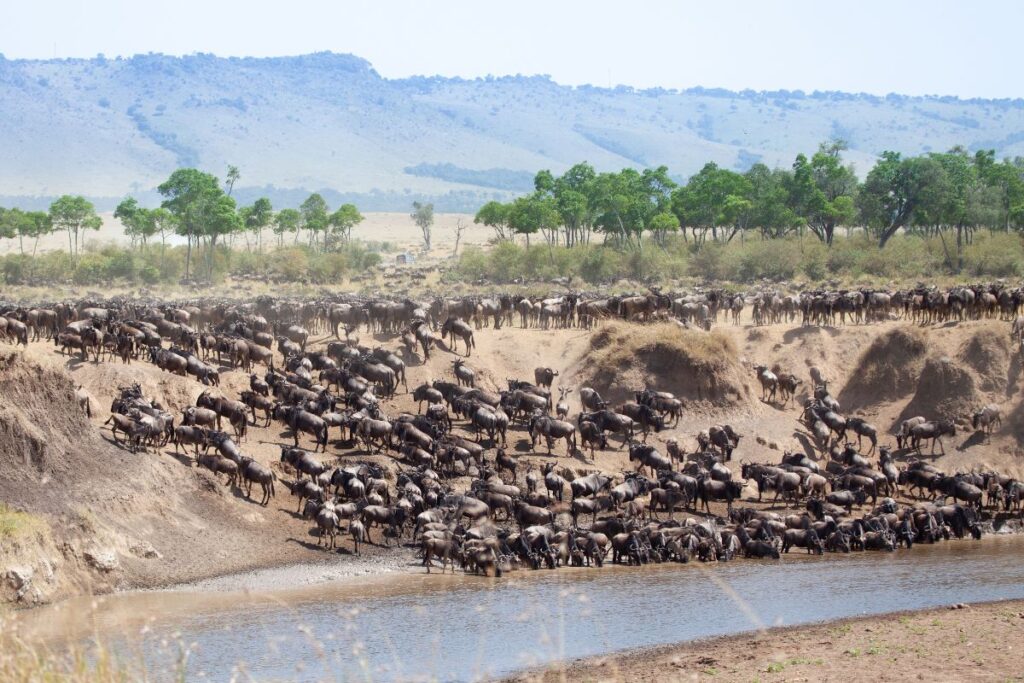
1. Private Game Drives
Private game drives provide an intimate and personalized safari experience during the Great Migration Masai Mara river crossing:
- Tailored Wildlife Tracking: Expert guides monitor herd movements, predator activity, and river crossings, ensuring travelers are always in the best position.
- Flexible Itineraries: Guests can adjust timings, routes, and focus areas for photography, wildlife observation, or quiet reflection.
Enhanced Safari Experience: Smaller groups mean more personalized attention and less crowding, allowing a deeper connection with the migration spectacle.
2. Five-Star Lodges
Luxury lodges elevate the experience of witnessing the Great Migration Masai Mara river crossing by combining comfort with proximity to nature:
- Scenic Accommodations: Rooms with panoramic views of the Mara River and surrounding savannahs offer constant access to wildlife spectacles.
- Exceptional Service: Attentive staff, gourmet meals, and thoughtful amenities ensure a seamless, indulgent stay.
Strategic Locations: Lodges are positioned near prime crossing points for early morning and late afternoon observations without lengthy drives.

3. Exclusive Bush Meals
Dining in the wilderness enhances the luxury safari experience during the Great Migration Masai Mara river crossing:
- Sunset River Dinners: Guests enjoy intimate meals while observing herds crossing the river or predators in action.
- Unique Culinary Experiences: Local flavors and expertly prepared dishes provide a memorable gastronomic dimension to the safari.
Immersive Atmosphere: Being close to wildlife and natural sounds creates a rare, fully immersive African experience.
These luxury offerings exemplify why travelers consider us the premier safari company for experiencing the Great Migration Masai Mara river crossing. By combining personalized attention, world-class accommodations, and exclusive experiences, we transform a natural spectacle into a once-in-a-lifetime adventure.
Mid-Range Adventures for the Great Migration Masai Mara River Crossing
Travelers seeking an immersive safari without compromising comfort find mid-range packages ideal for witnessing the Great Migration Masai Mara river crossing. These experiences combine affordability, adventure, and authenticity, allowing guests to connect deeply with Kenya’s wildlife and landscapes:
1. Boutique Lodges and Tented Camps
Our mid-range accommodations offer a perfect balance of comfort, accessibility, and proximity to the Great Migration Masai Mara river crossing:
- Immersive Stay: Guests experience nature up close while enjoying cozy, well-equipped lodges or tented camps.
- Scenic Locations: Accommodations are strategically located near river crossing hotspots for easy access to wildlife activity.
- Value and Comfort: Travelers enjoy quality facilities and attentive service without the premium cost of luxury lodges.
2. Guided Game Drives
Expert-guided game drives are central to the mid-range safari experience, ensuring travelers witness key moments of the Great Migration Masai Mara river crossing:
- Prime Observation Points: Guides position vehicles at the most active crossing sites for optimal viewing.
- Wildlife Education: Guests learn about herd behavior, predator-prey dynamics, and migration ecology during drives.
- Flexible Timings: Morning and afternoon drives are scheduled to coincide with peak wildlife activity and photography opportunities.
3. Cultural Interactions
Mid-range safaris offer enriching cultural experiences alongside wildlife observation during the Great Migration Masai Mara river crossing:
- Maasai Village Visits: Travelers gain insight into local traditions, livelihoods, and the historical significance of migration.
- Community Engagement: Guests can support sustainable initiatives and participate in authentic cultural activities.
- Integrated Safari Adventure: Combining wildlife and cultural immersion enhances the overall value and memorability of the safari experience.
These mid-range adventures provide a fully engaging, cost-effective way to experience the Great Migration Masai Mara river crossing. By balancing accessibility, comfort, and insider knowledge, our packages ensure travelers enjoy an unforgettable African wilderness journey.
Budget-Friendly Ways to Experience the Great Migration Masai Mara River Crossing
Witnessing the Great Migration Masai Mara river crossing doesn’t require a luxury budget. Our curated budget-friendly safaris combine accessibility, adventure, and expert guidance, allowing travelers to enjoy the spectacle without compromising on experience or safety:
1. Group Game Drives
Shared game drives provide an affordable way to access prime viewing points of the Great Migration Masai Mara river crossing:
- Cost-Effective Safari: Travelers share vehicles and guides, making it a budget-friendly option without losing quality.
- Prime River Access: Guides position groups at the most active crossing points for optimal wildlife observation.
- Social Experience: Group drives offer opportunities to connect with fellow travelers while enjoying the migration spectacle.
2. Local Campsites
Eco-friendly campsites bring budget travelers close to nature and the Great Migration Masai Mara river crossing:
- Immersive Experience: Guests stay near wildlife zones, enhancing early morning and evening observations.
- Comfort and Practicality: Campsites provide essential amenities while maintaining a natural, safe environment.
- Sustainable Options: Many local camps support community initiatives and conservation, adding value to the safari.
3. Expert Guidance
Even on a budget, knowledgeable guides ensure that the Great Migration Masai Mara river crossing experience is safe, educational, and unforgettable:
- Wildlife Tracking: Guides interpret herd movements, predator behavior, and river dynamics for guests.
- Safety First: Guests are guided through river observation areas with full attention to risk management.
- Storytelling and Learning: Travelers gain insight into the ecological and cultural importance of the migration.
These budget-friendly safaris prove that affordability doesn’t mean compromise. With expert guidance, safe accommodations, and strategic planning, travelers enjoy thrilling encounters and once-in-a-lifetime views of the Great Migration Masai Mara river crossing while staying within budget.
Photography Tips for the Great Migration Masai Mara River Crossing
Documenting the Great Migration Masai Mara river crossing is a once-in-a-lifetime opportunity that requires preparation, technique, and awareness of wildlife behavior. Our expert guides ensure travelers capture breathtaking moments while staying safe and minimizing disturbance to animals:
1. Use Telephoto Lenses
Telephoto lenses are essential for photographing the Great Migration Masai Mara river crossing from a safe distance:
- Close-Up Shots: Capture wildebeest, zebras, and predators without encroaching on their natural space.
- Dynamic Action: Telephoto zoom allows you to frame river crossings, splashing water, and dramatic predator interactions.
- Versatile Perspectives: Adaptable lenses help photograph both wide herds and individual animals in detail.
2. Consider Lighting
Lighting plays a critical role in enhancing images of the Great Migration Masai Mara river crossing:
- Golden Hours: Early mornings and late afternoons provide warm, soft light for dramatic effects.
- Shadows and Contrast: Natural lighting highlights textures, movement, and the vivid colors of the savannah.
- Weather Adaptation: Guides help plan drives around optimal lighting conditions to maximize photographic potential.
3. Plan Angles
Strategically choosing angles can dramatically improve photography outcomes during the Great Migration Masai Mara river crossing:
- Elevated Riverbanks: Offer unobstructed views of herd movements and predator-prey dynamics.
- Open Savannah: Wide landscapes showcase the scale of migration, creating iconic compositions.
- Guided Recommendations: Our experts suggest vantage points for safety, composition, and storytelling.
By following these photography tips, travelers not only capture stunning images but also enhance their overall experience of the Great Migration Masai Mara river crossing. Combining preparation, expert guidance, and the right equipment ensures every moment is documented in its full dramatic and natural beauty.
Wildlife You Will See During the Great Migration Masai Mara River Crossing
The Great Migration Masai Mara river crossing brings together an incredible array of wildlife in one dynamic ecosystem. Observing these species in their natural habitats offers travelers unparalleled insight into Africa’s rich biodiversity:

1. Wildebeest
Wildebeest are the central focus of the Great Migration Masai Mara river crossing:
- Massive Herds: Millions traverse the Mara River, creating dramatic scenes of survival and instinct.
- River Navigation: Their cautious and coordinated movements provide thrilling photographic and observational opportunities.
Ecological Role: Wildebeest grazing patterns influence vegetation, predator behavior, and overall ecosystem balance.
2. Zebras
Zebras often accompany wildebeest, adding vibrancy and coordination to the migration spectacle:
- River Crossings: Zebras negotiate currents with caution, often following herd leaders for safety.
- Distinct Patterns: Their striking black-and-white stripes offer excellent photographic contrast against the savannah.
Behavioral Insight: Watching zebras alongside wildebeest demonstrates interspecies cooperation during migration.

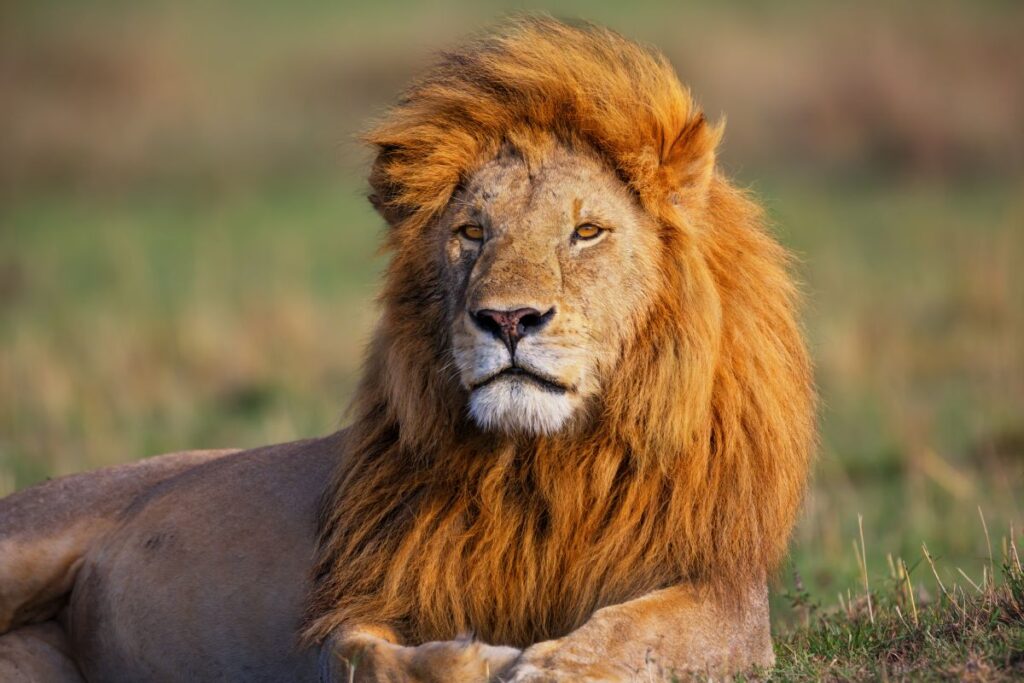
3. Predators
Predators play a critical role in the drama of the Great Migration Masai Mara river crossing:
- Lions and Hyenas: Hunt and stalk the migrating herds, providing intense, real-time encounters.
- Crocodiles: Lurk in river waters, creating suspenseful crossing scenes that define the spectacle.
Survival Observation: These predator-prey interactions offer valuable ecological and educational insights.
4. Birdlife
The Mara River and surrounding savannahs host a vibrant variety of bird species:
- Kingfishers and Storks: Frequent riverbanks, adding dynamic color and movement to the landscape.
- Eagles and Vultures: Soar above, offering dramatic aerial perspectives for wildlife enthusiasts.
Ecological Connection: Birds provide cues on predator presence and herd movement, enhancing the overall safari experience.

Observing these species up close during the Great Migration Masai Mara river crossing allows travelers to witness the delicate balance of nature, the drama of survival, and the beauty of one of the world’s most extraordinary wildlife phenomena.
How to Plan Your Great Migration Masai Mara River Crossing Safari
Planning is critical for experiencing the Great Migration Masai Mara river crossing in all its drama and grandeur. Without proper preparation, travelers risk missing peak crossings, optimal photography opportunities, and cultural encounters that make this safari unforgettable. Our step-by-step planning process ensures your journey is seamless, safe, and fully immersive:
1. Consultation
The first step in your Great Migration Masai Mara river crossing adventure begins with a detailed consultation:
- Personalized Needs Assessment: Share your travel dates, safari interests, photography goals, and comfort preferences. This ensures the safari is tailored to your vision.
- Expert Timing Advice: Our guides analyze historical migration patterns and river levels to recommend the best travel window for witnessing peak crossings.
- Budget and Experience Planning: We provide realistic options for accommodations, transport, and safari activities that balance cost, comfort, and adventure.
- Special Requests: Whether it’s a family-friendly experience, a honeymoon safari, or a photography-focused trip, we integrate your preferences into the plan.
2. Itinerary Design
Once we understand your requirements, we create a detailed, customized itinerary for your Great Migration Masai Mara river crossing safari:
- Targeted Game Drives: Strategically scheduled drives to coincide with peak herd movements and predator activity, maximizing your chances of witnessing dramatic river crossings.
- Cultural Immersion: Optional Maasai village visits and interactions with local communities to understand how the migration shapes traditions and daily life.
- Photography Optimization: Timed excursions for early morning or late afternoon light, access to elevated riverbanks, and guidance on positioning for safe yet striking shots.
- Multi-Day Planning: For extended safaris, we organize routes that combine the Mara River crossing with nearby parks and conservancies, enhancing wildlife diversity and scenic variety.
3. Booking & Confirmation
After your itinerary is finalized, we handle every logistical detail for your Great Migration Masai Mara river crossing safari:
- Accommodations: Carefully selected lodges, tented camps, or eco-camps situated near the Mara River to provide comfort, convenience, and proximity to wildlife.
- Permits and Park Fees: Securing all park entries, conservancy permits, and special access fees, so you don’t face delays or restrictions during the safari.
- Transport Arrangements: Reliable 4×4 vehicles equipped for rough terrain, with options for private or shared drives depending on your budget and preferences.
- Travel Insurance and Safety Measures: Recommendations to ensure peace of mind during the safari, particularly for river crossing observation and wildlife encounters.
4. Preparation
Before your departure, we provide thorough guidance to maximize your experience during the Great Migration Masai Mara river crossing:
- Packing Recommendations: Essential clothing for variable weather, safari hats, binoculars, telephoto lenses, waterproof gear, and personal items for multi-day adventures.
- Health & Vaccinations: Tips on recommended vaccinations, insect repellents, hydration, and sun protection to ensure safe participation in safari activities.
- Wildlife Etiquette: Instructions on observing animals safely and responsibly, including riverbank behavior, distance from predators, and minimizing disruption during crossings.
- Photography & Storytelling Tips: Guidance on capturing action shots, understanding wildlife behavior, and selecting vantage points to document dramatic crossings effectively.
- Emergency Planning: Strategies for minor injuries, sudden weather changes, or vehicle breakdowns, ensuring uninterrupted enjoyment of the Great Migration Masai Mara river crossing.
By following this comprehensive planning process, travelers can enjoy a fully immersive and unforgettable Great Migration Masai Mara river crossing experience. Every step — from consultation and itinerary design to booking, preparation, and expert guidance — ensures that the adventure is safe, exhilarating, and deeply connected to Africa’s wild landscapes.
Accommodation Options During the Great Migration Masai Mara River Crossing
The experience of the Great Migration Masai Mara river crossing is enhanced not only by being in the right location but also by choosing the right accommodation. Where you stay can transform your safari from ordinary to extraordinary, offering comfort, immersion, and direct access to the unfolding drama of wildlife. Our carefully curated accommodations cater to every type of traveler and ensure you don’t miss a single moment of the river crossing:
1. Luxury Lodges
Luxury lodges are designed for travelers who want the ultimate combination of comfort and immersive wildlife viewing during the Great Migration Masai Mara river crossing:
- Panoramic River Views: Guests can observe wildebeest and zebras crossing the Mara River from private balconies or terraces, offering uninterrupted vantage points.
- Exceptional Amenities: From fine dining and spa treatments to private guides and 4×4 game drives, these lodges offer an indulgent safari experience without compromising access to wildlife.
- Exclusive Experiences: Personalized activities such as dawn game drives, bush breakfasts near the river, and sunset cocktail sessions allow travelers to witness the Great Migration Masai Mara river crossing in unmatched style.
- Privacy and Safety: Luxury lodges combine seclusion with expert guidance, ensuring a safe and intimate viewing of predator-prey interactions along the riverbanks.
2. Tented Camps
Tented camps provide a balanced experience of adventure, comfort, and proximity to the Great Migration Masai Mara river crossing:
- Prime Locations: Positioned near major crossing points, these camps allow travelers to be among the first to witness wildebeest herds tackling the Mara River.
- Comfortable Accommodations: Semi-permanent tents with en-suite facilities, plush bedding, and verandas ensure a cozy retreat after full-day game drives.
- Immersive Safari Ambience: The open-air design brings the sights, sounds, and scents of the savannah into your stay, making every river crossing moment more vivid.
- Cost-Effective Luxury: Tented camps combine the thrill of proximity to wildlife with comfort that suits travelers seeking a mid-range safari experience.
3. Eco-Camps
Eco-camps are perfect for environmentally conscious travelers who want to witness the Great Migration Masai Mara river crossing while supporting conservation efforts:
- Sustainable Design: Use of solar energy, water-saving practices, and minimal-impact construction helps preserve the Mara ecosystem.
- Immersive Wildlife Experiences: Camps are situated strategically to allow unhindered views of the river crossings, wildebeest herds, and predator activity without disturbing natural behavior.
- Community Involvement: Many eco-camps support local Maasai communities through employment, education, and conservation programs, allowing travelers to contribute positively to the region.
- Authentic Connection: Staying in an eco-camp provides a raw, close-to-nature experience that enhances understanding of the Great Migration Masai Mara river crossing dynamics.
By choosing the right accommodation type — whether luxury lodges, tented camps, or eco-camps — travelers optimize their experience of the Great Migration Masai Mara river crossing. Each option ensures access to prime river viewpoints, immersive wildlife encounters, and a seamless blend of comfort, adventure, and sustainability. With thoughtful lodging, every moment of the river crossing becomes an unforgettable highlight of your safari.
Why Choose Us for the Great Migration Masai Mara River Crossing
Experiencing the Great Migration Masai Mara river crossing is a once-in-a-lifetime adventure that requires expertise, planning, and trusted guidance. Selecting the right safari operator ensures your journey is safe, seamless, and memorable. Here’s why travelers consistently choose us for this extraordinary wildlife spectacle:
1. Expert Guides
Our professional guides possess extensive knowledge of wildlife behavior, migration routes, and predator-prey interactions. They track herd movements with precision, ensuring travelers witness the dramatic river crossing moments at the perfect location and time. Beyond navigation, they provide fascinating insights into the ecosystem, conservation efforts, and animal behavior, enriching every encounter during the migration.
2. Reliable Coordination
We manage every aspect of the safari to provide a stress-free experience. Transportation in rugged 4×4 vehicles, secured park permits, and carefully selected accommodations ensure that travelers focus entirely on enjoying the spectacle. Daily itineraries are optimized to align with herd movements and peak activity hours, allowing guests to experience the river crossing safely and efficiently.
3. Sustainable Practices
Responsible tourism guides every decision we make during the Great Migration Masai Mara river crossing. We partner with eco-friendly lodges and camps to minimize environmental impact while ensuring that safaris positively support local communities through employment, education, and cultural preservation. Travelers can witness this natural phenomenon knowing their journey contributes to conservation and local livelihoods.
4. Personalized Service
Each safari is customized to meet individual traveler preferences, from flexible game drives and private river crossing viewpoints to photography guidance and cultural interactions. Early morning or late afternoon departures can be arranged for optimal viewing, while dedicated consultants provide continuous support from inquiry through post-safari follow-up. Every itinerary is designed to maximize enjoyment, comfort, and unforgettable memories.
Traveling with us guarantees not only front-row access to the Great Migration Masai Mara river crossing but also expert insight, immersive adventure, and personalized care that transform every river crossing moment into a highlight of a lifetime.
Travel Tips for the Great Migration Masai Mara River Crossing
1. Dress Appropriately
Wearing neutral-colored clothing helps you blend into the savannah environment, allowing for unobtrusive wildlife observation. Lightweight, breathable fabrics and layers for fluctuating temperatures ensure comfort throughout early morning and late afternoon game drives.
2. Essential Gear for Observation
Bring binoculars and cameras with telephoto lenses to capture close-up views of wildlife safely. A sturdy tripod, extra memory cards, and protective camera gear will enhance your ability to document the dramatic river crossing moments without disturbing animals.
3. Stay Hydrated and Energized
Long hours on game drives require proper hydration and light snacks. Carry a refillable water bottle, energy bars, or fruits to maintain energy levels, ensuring you remain alert and engaged throughout the safari experience.
4. Respect Wildlife and Follow Guide Instructions
Maintaining a safe distance from animals is critical for your safety and the well-being of the wildlife. Follow all guidance from your professional safari guides, including positioning during river crossings and vehicle etiquette, to enjoy a safe and responsible encounter.
5. Schedule Strategically
Plan your visit during peak migration months, typically between July and October, for the best chance to witness the river crossings. Understanding seasonal variations, river levels, and optimal viewing hours maximizes your experience of this extraordinary natural spectacle.
By following these practical tips, travelers enhance their comfort, safety, and ability to fully immerse themselves in the Great Migration Masai Mara river crossing, creating unforgettable memories and remarkable photography opportunities.
Frequently Asked Questions About the Great Migration Masai Mara River Crossing
Planning to witness the Great Migration Masai Mara river crossing raises many questions for first-time and returning travelers alike. Here are comprehensive answers to help you prepare, plan, and make the most of your safari:
1. When is the best time to see the Great Migration Masai Mara river crossing?
The prime months for observing the river crossing are from July to October, when vast herds of wildebeest, zebras, and gazelles move from the Serengeti into the Mara. Our guides track herd patterns daily, taking into account rainfall and river levels, to ensure travelers are positioned at the most active crossing points. By visiting during these peak months, you increase the chances of witnessing multiple crossings, predator interactions, and stunning wildlife behaviors.
2. How long should I stay to witness the river crossing?
A minimum of 3–4 days is recommended for fully experiencing the Great Migration Masai Mara river crossing. This duration allows multiple game drives at different river points, time for cultural visits to Maasai communities, and opportunities for photography during the best light. Longer safaris offer flexibility for relaxation, extra wildlife encounters, and immersive experiences with the savannah ecosystem, ensuring your trip is both comfortable and unforgettable.
3. Which river crossing points are the best for viewing?
Strategic locations like Crocodile Bridge, Sand River Campsites, and Mara North Conservancy provide optimal perspectives. Crocodile Bridge offers high predator activity and dramatic river crossings, Sand River provides elevated, unobstructed views perfect for photography, and Mara North Conservancy ensures private, less crowded experiences. Our guides select these spots based on herd movement, predator presence, and accessibility to enhance every river crossing encounter.
4. Is it safe to witness predators during the crossing?
Yes, safety is a top priority. Trained guides maintain secure distances and carefully choose vantage points, allowing travelers to witness lions, crocodiles, and hyenas without risk. We provide education on animal behavior, ensuring that guests understand the dynamics of predator-prey interactions while keeping every moment thrilling yet secure.
5. Do I need special equipment for photography?
Professional-quality photography requires preparation. Telephoto lenses allow detailed close-ups of wildlife, while a sturdy tripod ensures stability for low-light shots during sunrise or sunset game drives. Additional batteries, memory cards, and protective gear safeguard your equipment. Our guides advise on optimal shooting angles, lighting conditions, and positioning, helping you capture iconic river crossing moments without disturbing the wildlife.
6. Can families with children witness the river crossing?
Absolutely. Safaris are tailored to accommodate all ages safely. Shorter, engaging game drives, interactive educational experiences, and family-friendly lodges make the Great Migration Masai Mara river crossing accessible and enjoyable for children. Parents can relax knowing guides prioritize safety while introducing young travelers to wildlife and the ecological significance of the migration.
7. Are there eco-friendly accommodations near the river crossings?
Yes, sustainability is central to our operations. Lodges and camps prioritize renewable energy, waste reduction, and water conservation. Some properties actively support conservation programs and community development initiatives. Choosing eco-friendly accommodations ensures that travelers experience the river crossing responsibly while contributing positively to the Mara ecosystem.
8. What should I pack for a Great Migration safari?
Essential items include neutral-colored clothing, sturdy footwear, hats, sunscreen, binoculars, and a camera. Layered clothing helps manage varying temperatures, while practical accessories like water bottles and insect repellent enhance comfort. Packing thoughtfully ensures a smooth, enjoyable, and safe experience throughout game drives, river crossings, and cultural visits.
9. Can I combine the river crossing with other safari destinations?
Yes, multi-destination itineraries allow travelers to experience Amboseli, Lake Naivasha, and other iconic parks. Combining destinations provides a broader perspective of Kenya’s wildlife and landscapes while offering additional activities like birdwatching, hiking, or cultural excursions. Customized itineraries ensure a seamless and immersive safari that balances the river crossing spectacle with diverse wildlife adventures.
10. How do I book a Great Migration Masai Mara river crossing safari?
Booking directly with us ensures a fully personalized experience. Our team handles itinerary planning, park permits, accommodation arrangements, and game drive scheduling. This approach guarantees maximum opportunities to witness the river crossing while offering expert guidance, sustainable travel practices, and a safe, memorable journey from start to finish.
11. Can I witness multiple river crossings on a single safari?
Yes, observing several river crossings is possible with expert planning. By tracking herd movements and understanding seasonal patterns, we position travelers at different points along the Mara River. This increases the likelihood of seeing diverse wildlife interactions and dramatic river crossings during your stay.
12. What wildlife can I expect to see at the river crossing?
The river crossing showcases a dynamic ecosystem. Travelers will witness vast herds of wildebeest and zebras, predators such as lions, hyenas, and crocodiles, and an array of birds including storks and kingfishers. These encounters provide a rare opportunity to observe survival strategies and predator-prey interactions in a natural setting, making the experience educational and awe-inspiring.
Book Your Great Migration Masai Mara River Crossing Safari with Sparwild African Tours and Safaris
Experience the thrill, beauty, and drama of the Great Migration Masai Mara river crossing with Sparwild African Tours and Safaris. Book now to secure expert guidance, luxury or mid-range accommodations, and a seamless, unforgettable journey into one of Africa’s most spectacular wildlife events. Don’t wait — your adventure of a lifetime begins today with the best safari tour operator in Kenya.
PARTNERS AND ACCREDITATIONS
Resource Links
ABOUT US
Sparwild African Tours and Safaris is a trusted best tour operator in Kenya offering unforgettable African tours and safaris across Kenya, Tanzania, and East Africa. We design tailor-made safari packages that connect travelers with nature, wildlife, and authentic African culture while promoting responsible and sustainable tourism.
TOP SAFARIS
OFFICE ADDRESS
Ruiru Town, Kenya
Phone: (+254) 703 829 961
Info@sparwildafricantoursandsafaris.com
Kenya Travel Guide
Kenya Safari Planning Tips
Kenya Safari Seasons
Sparwild African Tours and Safaris
Kenya Wildlife Travel Guide
Wildlife Migration in Kenya
Kenya Safari Travel Guide
Wildlife Safari in Kenya
Best National Parks in Kenya
Kenya Holiday Travel
Safari Destinations in Kenya
Top Game Reserves in Kenya
Best Time to Visit Kenya
Best Time to Visit Africa
Wildlife Sanctuaries in Kenya


